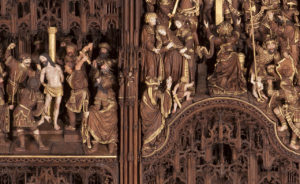Publication of the proceedings of the conference on the Saint-Denis altarpiece, held at the Royal Institute for Cultural Heritage in Brussels from 22 to 24 October 2015.
The volume includes a contribution by Catheline Périer-D’Ieteren: La huche du retable de Saint-Denis. Un produit de l’atelier des Borman.
More details on the publisher’s website: Brepols.
Summary:

The impressive altarpiece in the church of Saint-Denis in Liège is one of the most prestigious but also one of the most enigmatic witnesses to the rich Brabantine altarpiece production at the end of the Middle Ages. The interdisciplinary study carried out during its restoration at the Royal Institute for Cultural Heritage (KIK-IRPA) in Brussels between 2012 and 2014 allowed to resolve some of the questions involved and to propose new refreshing hypotheses. The attribution to the Borman, the most prestigious Brussels sculptor family, was refined, as was its dating in the early 1530s, when the vocabulary of Italian Renaissance began to invade the art of the Meuse banks simultaneously with the still well-anchored Gothic style.
This volume provides a broad platform for the exceptional character of the partial polychromy of the altarpiece, highlighted by the investigation conducted at the KIK-IRPA. This research was nourished by many comparative reflections. The abundant and varied studies presented here, mainly originate from an international conference held in October 2015. In addition, the restoration at KIK-IRPA, between 2016 and 2019, of some of the painted panels that initially adorned the shutters of the altarpiece, also allowed a beneficial reconsideration of the participation of the great Liège painter Lambert Lombard and some local workshop. Starting from an amazing work, they represent an important part of the artistic activity in Liège revived by Prince-Bishop Érard de La Marck.
